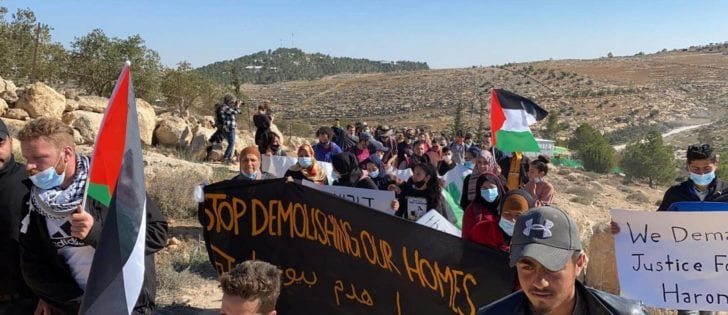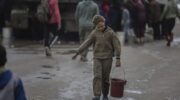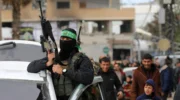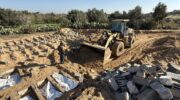Sami Huraini, left, protesting against the shooting of Harun Abu Aram prior to his arrest
Activist Sami Huraini, 23, is one of the coordinators of a West Bank youth group engaged in weekly demonstrations. His family history of nonviolent protest has yielded some unlikely victories.
by Jonathan Shamir and Nicolas Rouger, reposted from Ha’aretz, Feb. 23, 2021
Palestinian law student Sami Huraini can be found every Friday at Kiryat Arba police station. The 23-year-old activist’s bail conditions stipulate that he must appear here weekly, in the Israeli settlement abutting Hebron, from 8:30 A.M. until 3 P.M.
Usually at this time, Huraini would be attending the weekly after-prayer demonstration in or near his West Bank village of At-Tuwani, protesting the occupation and a spike in home demolitions by Israeli military authorities in this desert-like area in the South Hebron Hills.
“They want to scare me from joining any demonstration, and they want to use me as an example to scare other activists,” Huraini says of the bail conditions, which will run at least until his next court hearing on March 1.
If he’s discovered attending a protest, he will forfeit his 10,000-shekel (around $3,000) bail – equivalent to two-and-a-half months of his father’s salary. “Even if I’m walking down the road and there’s a protest, they could arrest me,” Huraini says.
If an Israeli military court has reason to believe he helped organize a protest, he will also have to surrender another 30,000 shekels (which his father and other activists put down as a guarantee). “It’s not easy,” Huraini told Haaretz in a phone interview after his release. “I don’t want to stop.”
As the coordinator of Youth of Sumud, a collective of 30 young activists from At-Tuwani and neighboring villages, Huraini is one of the central figures in local attempts to counter what they see as the ever-growing influence of the Israeli occupation, and to inspire locals to stay on their lands in the face of mounting pressure.
Huraini is facing charges of disturbing the peace, assaulting an Israeli soldier and violating a closed military zone order during an unsanctioned demonstration on January 8, near the adjacent village of Al-Rakeez.
According to a report by the Association for Civil Rights in Israel, the oldest human rights organization in the country, the imposition of closed military zones is overwhelmingly used as a “tool for suppressing protest in the West Bank.” Huraini also views the justification as an “excuse.” At the time, 200 Palestinian, Israeli and international activists were protesting the shooting of Harun Abu Aram, 24, by Israeli soldiers the previous week.
Fifteen Israeli soldiers came to Huraini’s house on the same night, he says. “Have you got a knife?” he recalls them asking. “You pull me out of bed and you ask if I have a knife?” he replied. Blindfolded and handcuffed, he was driven from one military base to another until, at 4 A.M., he was taken to Kiryat Arba police station for interrogation. At 9 A.M., he was escorted to Gush Etzion jail, where he stayed for six days while his court date kept being pushed back, he recounts.
Despite his age, this is far from the first time Huraini has run afoul of the Israeli authorities. In fact, just like his father Hafez and his grandmother Fatima before him, he knows he can expect such treatment to continue for as long as he keeps protesting.

Raised on activism
Barely more than 300 people live in At-Tuwani, a small cluster of concrete homes hugging a rocky hill south of Hebron. But the school, the clinic and the mosque have made it into a center of sorts for the small communities dotting the hills around it.
The Hurainis moved there in 1948 from near the city of Arad, some 20 kilometers (12 miles) south as the crow flies and on the other side of the armistice line that marks Israel’s internationally recognized borders. Fleeing from the fighting in the War of Independence, they bought land from people in the nearby town of Yatta and went on as they had always done: farming and sheep herding.
Everything changed in 1981. The Israeli military built the outpost of Ma’on, a stone’s throw from At-Tuwani, for a group from Nahal, an Israeli army unit that combined military service with agriculture, and it became a settlement a year later. In 2001, radical settlers built an unrecognized extension known as Havat Ma’on, closer to At-Tuwani.
In the last 30 years, At-Tuwani was hardly allowed to expand, and the manicured settlement now dwarves it with close to 600 inhabitants. A new neighborhood was just built, overlooking cherry orchards softly going down into the small valley between the two hills. “That was my family’s land,” Sami Huraini says.
Fatima Huraini, Sami’s grandmother, is well into her eighties. Even when the settlement was in its infancy, violence was already a feature. She was often assaulted by settlers while grazing her sheep. She was also beaten by the army and lost her hearing on one occasion, says Sameeha Huraini, Sami’s younger sister.
Yet she stayed put, in a display of what Palestinians call sumud (“steadfastness” in Arabic) – a central concept in the local history of activism. Her son Hafez, now in his fifties, also became a prominent popular resistance activist in the West Bank, and particularly in the South Hebron Hills. He also faced nighttime raids and arrests, Sameeha recounts.

“I grew up in this context, I was raised on those principles,” Sami Huraini says. “It taught me to have faith and commit to nonviolence as an effective and influential way to achieve peace and justice.”
In 2017, the Huraini children and some of their friends established Youth of Sumud. They practice “peaceful popular resistance as a strategic choice to end the Israeli occupation,” Sami explains, though their immediate aim is more prosaic: “The IDF uses violence as an excuse to demolish houses. We practice direct action in order to destroy the plan to take the land away from us,” he says.
The small activist movement was formed at the Sumud Freedom Camp, during which Palestinian, Israeli and international activists occupied caves in the nearby village of Sarura in an effort to bring back the original occupants who had been chased away, they said, by regular settler attacks.
The caves are still a key concern, but Youth of Sumud now also engages in other activities – including documenting settler violence and army demolitions, providing a protective presence on school runs and during harvest season, and hosting workshops and lectures on nonviolent theory and practice.
According to the Israeli human rights group B’Tselem, the South Hebron Hills is of particular strategic interest to Israel because it is sparsely populated and there is territorial contiguity with the Negev to the south.
It is also a biblical heartland, a place where devout Jewish settlers might feel a rejuvenating sense of belonging. Haaretz reached out to the Har Hebron Regional Council, under whose jurisdiction Ma’on falls, and to individuals from the community, in order to understand these motivations. However, they were unwilling to respond to questions.
The desert climate here means it is home to scattered Palestinian enclaves that often vary with the seasons or the weather. Over time, this has made the communities increasingly isolated, especially as they see their development curtailed by the lack of critical infrastructure, the impossibility of obtaining building permits and what they say is constant harassment from both Israeli civilians and the military.

Yet Michael Carpenter, a researcher at Canada’s University of Victoria, who specializes in civil resistance, says the residents of At-Tuwani can point to some “little victories.”
For example, it is one of the few Palestinian villages with a “master plan” from Israel, which allows locals to build on their land; they managed to hook up to the water supply, which is also unusual; and in 2006, after the State of Israel built a meter-high wall along route 317, cutting off the South Hebron Hills from other parts of the West Bank, the local villages banded together and began demonstrating on a weekly basis for two years – until the section of barrier was eventually removed.
In contrast to other forms of resistance, “sustained protests draw a space for political activism … and have the appeal to build support locally and transnationally, which is crucial,” Carpenter says. “Israeli soldiers and commanders have said that cameras are their kryptonite,” he says, referring to documentation of nonmilitarized protest.
He also points out the unique circumstances of protest in Area C, the part of the West Bank under full Israeli control: “Where the Palestinian Authority is, popular resistance is not,” Carpenter says. “The Palestinian police, but also the Palestinian infrastructure, act as pacifying factors.”
The price of nonviolence
The prison at Gush Etzion is “particularly bad,” local activist Basil Adra told Haaretz while Huraini was being held there. After his release, Huraini concurs. He was only given permission to talk to his family once during his six days inside. There was support for him outside, however. As his court date kept getting pushed back, Palestinian and Israeli supporters demonstrated outside the prison daily.
Explaining Huraini’s arrest and indictment, the Israel Defense Forces told Haaretz that he “took part in a protest during which he used violence against soldiers and encouraged other protesters to do the same and not to listen to the soldiers’ orders. The IDF takes seriously any case of violence against its soldiers and will act to hold accountable those who use such violence.”

Aside from testimonies from security forces, the prosecution has not provided evidence that Huraini carried out the violent acts he was indicted for. Israeli soldiers can clearly be seen wearing body cameras during the incident on January 8, but no footage was made available, as is often the case. When asked specifically about this by Haaretz, the Israeli military chose not to answer.
According to several eyewitnesses, as well as footage of the demonstration, the protest was overwhelmingly peaceful. “We protested peacefully with international and Israeli activists: chanting, drumming and waving flags,” Adra said.
Five Israelis who attended the demonstration even submitted an affidavit for Huraini’s court hearing. Regarding the charge that Huraini violated a military closure order, activists Oriel Eisner and Renana Na’aman, who also testified to the police, said that no military closure order was presented to the protesters.
Another activist present, Karen Isaacs, also felt compelled to submit an affidavit. “The gap between the accusations and the reality in this case just felt so enormous, and I wanted to do my part as someone who was present and nearby to Sami during the demonstration,” she explained. “I would have seen if he had assaulted anyone, and he certainly did not do so,” she said.
Huraini’s lawyer, Gaby Lasky, said the fact that the army had detained her client, and an indictment “was filed against him for attacking soldiers despite the numerous testimonies of Israelis who were with him at the scene, indicates the attempt by law enforcement authorities in the territories not only to silence protest and criticism against the illegal shooting [of Harun Abu Aram], but also severely damage the fabric of life of villagers.”
Temptation to leave
The temptation for the locals to leave At-Tuwani is enormous. It takes Huraini more than 90 minutes to reach Hebron University, for instance, even though it’s only a 30-minute ride on the settlers-only bus from Ma’on.

During a visit to the village last November, Haaretz joined Huraini on one of Youth of Sumud’s regular activities: accompanying schoolchildren home to the nearby village of Tuba. The half-hour route goes through Ma’on, and since 2004 the IDF has provided an armed escort in order to prevent attacks by settlers.
When the IDF doesn’t show up, activists have to escort the children themselves, at considerable risk. International activists often join in regular times, but this is not an option during the pandemic.
After waiting for close to an hour, we saw a white IDF armored van eventually drive up the hill. The soldiers did not get out, and the small group started walking. One of the girls, Shuruq, wearing a white veil, walked briskly at the head of the group. A year before, she had been hit in the head with a stone and had to go to hospital. “A lot of them leave school,” Huraini told us.
Huraini himself was also attacked by settlers in an all-terrain vehicle. He shows us footage of the incident, but it’s grainy. He rewinds and lets us watch it again, as if we were not going to believe him. Although he registered a complaint and said he could identify the assailants, he says the police never contacted him.
On our way back through the same path, a white pick-up drove by. Inside, a bald man wearing sunglasses recorded us on a camera. A month later, Huraini was summoned to Kiryat Arba police station and interrogated.
He had trespassed on Ma’on’s land “with four friends,” an officer told him, and there was video evidence. They were only interested in him, apparently, not those accompanying him.
He told them that if he had entered Havat Ma’on, it was by mistake. However, his lawyer for this particular case, Riham Nassra of Gaby Lasky & Partners, later clarified: “There’s no such thing as ‘accidental trespassing,’ Trespassing must have an element of intent to it … so there were almost certainly no legitimate charges against him.”
She continued: “While the police aren’t obliged to show the evidence, it’s reasonable to assume they don’t have anything on him.”
Huraini was never shown the evidence, but says he was told he had to pay 500 shekels or go to jail. He only had 100 shekels on him, and an exam the next day. The officers took the money and let him go, he says, and he wasn’t given any form of receipt.

Without paperwork, Sami Huraini will not be able to claim the money back, as he should be able to after 180 days. As for the apparent haggling, this isn’t “kosher,” a police source told Haaretz. “‘It’s the police, it’s not the Carmel Market,” the source added.
In 2020, Youth of Sumud planted some olive trees right next to a Jewish National Fund-planted forest between Ma’on and At-Tuwani.
The aim, Huraini said, was to try to physically stem the potential encroachment of the settlement, while giving young people a renewed sense of ownership over the land.
A few weeks later, as the saplings made their way out of the ground, they were uprooted, and not for the first time. Who did it? “The settlers – who else?” Huraini shrugged.
His own roots to this land remain as firm as ever, though. “We want a normal life in our village, to live in dignity,” Huraini said.
“We just want to leave behind the trauma and live in safety. And for the apartheid system to fall.”
This Friday, while he reports once more to Kiryat Arba police station, his fellow young activists will be out again in At-Tuwani, continuing their struggle.
ESSENTIAL READING:
- Jake Tapper, Meet Sumud – Palestinian Resilience
- Thanks to the US, the Israeli Military Shot My Cousin, Harun Abu Aram
RELATED READING:
- Israel’s Covid response is a “moral failure” – WHO
- Torture of Palestinian prisoners: Time to end Israel’s impunity
- Israeli soldiers break the silence about midnight invasions of Palestinian homes
- Israeli soldiers cheer after shooting Palestinian man
- Israeli checkpoint killing of Palestinian Ahmad Erekat was an execution, report claims
VIDEOS:





